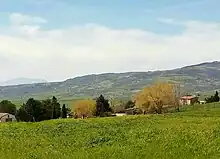Contrada
A contrada (plural: contrade) is a subdivision (of various types) of Italian city, now unofficial. Depending on the case, a contrada will be a località, a rione, a quartiere (terziere, etc.), a borgo, or even a suburb. The best-known contrade are the 17 contrade of Siena, since they form the teams in the palio di Siena.

In some parts of Southern Italy and Sicily, a contrada is a subdivision of a comune, also administrative. In other regions, as in most of Lombardy, it may simply be a street, but with historical and social importance; however in Mantua contrada indicates a street in the old town.
In Veneto, particularly near the Alpine foothills, contrà is a smaller hamlet in a rural area (a group of houses usually smaller than a frazione). A synonym is colmel (Ital. colmello); in some municipalities, mostly populated contrae are administered as neighbourhoods (Ital. quartieri; e.g. in Bassano del Grappa, historical contrae of Campese, Sant'Eusebio, Valrovina, San Michele and Marchesane have each a neighbourhood council); in Noale, contrae are the seven subdivision that compete in the local palio. In Vicenza, a contrà used to be a neighbourhood in the town centre, but now it replaces the noun via (street) in the old town. In Venice, each sestiere was subdivided in contrade.
In Florence, a contrada is a street of secondary importance. The term is not used officially, however.
In the Republic of San Marino, contrada indicates a street within an inhabited area (e.g. contrada del Collegio and contrada Omerelli in the city of San Marino).